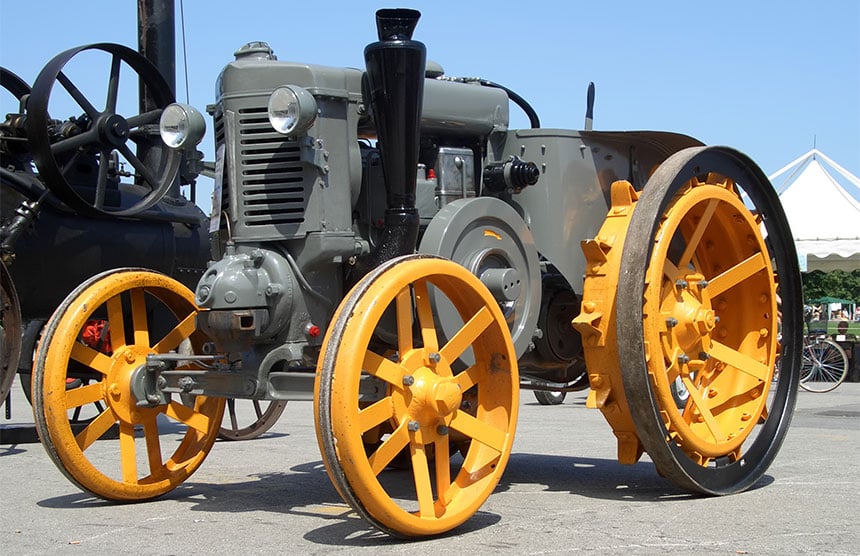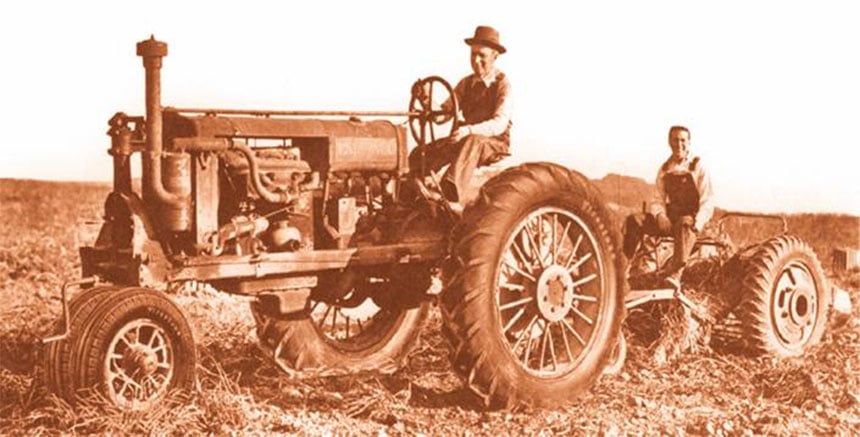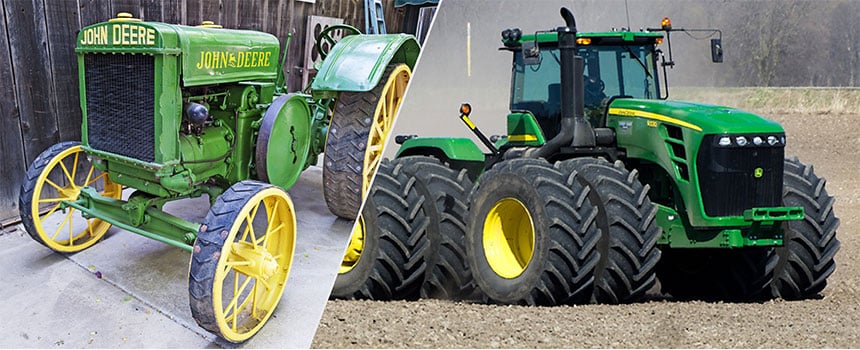Tyres have continued to evolve constantly since the invention of the agricultural tyre by Harvey Firestone in 1930, the tyre having never ceased to adapt to serve the needs of farmers better.
Over long periods of time, trends take shape which make it possible to define exactly what works best and what allows you to really improve productivity and yields. This kind of information lets you know what the current trends are on the agricultural tyre market and helps you to make an enlightened choice, if you wish to renew your tyres.
1. Why do tyres evolve?
The world population has gone from 3 billion people in 1960 to more than 7.5 billion today. At the same time, the average level of cereal production in the world increased from 217 kilos per inhabitant in 1963 to 354 kilos per inhabitant in 2013, which is an increase of around 65% in 50 years.
Agricultural equipment follows this evolution of demand and has brought about changes in social structure and productivity in farms.
The transition has taken place over several decades in western countries where family farms with staff and lots of light operating equipment have become family farms with few staff, equipped with heavy powerful equipment, the change coming about at the level of the machines which have led to a major increase in productivity.
The tyre is no exception and has followed the evolution of machines with new requirements linked to the constantly increasing weight of the tractors and the desire to avoid soil compaction, which would be counterproductive, as much as possible.
Tyres have evolved considerably over the last century:
1920
Iron star wheels

1930
Harvey Firestone invents the agricultural tyre, 2-wheel drive tractors are equipped with diagonal structure tyres

1940
First appearance of the radial structure tyre for 2-wheel drive tractors
1950
4-wheel drive tractors appear equipped with diagonal structure tyres
1970
4-wheel drive tractors may be equipped with radial structure tyres
2010
First appearance of low-pressure radial structure tyres with IF or VF technology
2020
First appearance of autonomous tractors, connected devices and onboard artificial intelligence

2. Evolutions of the diagonal tyre to the VF tyre
There are three main periods in the evolution of agricultural tyres:
- Original diagonal structure tyres are still on sale today and have a real legitimacy for certain activities or work which require sidewalls as solid as the tread. They are useful for work on hard ground, in the farm courtyard for animal breeding activities for example, or for forestry or construction site work.
- The arrival of radial structure tyres is a major evolution but only for certain agricultural activities, and in particular one of the most important: working the land, crop farming, tilling and harvesting. This form of tyre is better suited to tilling with the pressure is spread evenly beneath the tread footprint, reducing the local compaction caused by diagonal structure tyres.
- Low-pressure IF then VF technology tyres are in turn an evolution of the radial structure tyre with the possibility of working the land while avoiding soil compaction, by improving traction and solving the problem of slippage.
In short, a major improvement in productivity for all crop farming farms.
3. Generalisation of market trends and choices
Trends evolved throughout the 1990s, leaning towards larger tyres to increase the size of the soil footprint, making it possible to improve traction while limiting soil compaction with a better load distribution over a larger contact patch with the ground.
Tyres went from 85-series, commonly used before the 1980s, to larger 70-series, then from the 1990s, 65-series to increase the soil footprint even more.
This evolution in series made it possible to improve the tractors’ traction capacity without changing the height of the tyres, thus optimising productivity and saving time on each campaign.
From the year 2000 onwards, high volume extra-large XL tyres marked an important change, moving towards increasingly higher tyres. The advantage of this evolution also lies in the improvement of traction thanks to tyres with a longer soil footprint. As more lugs grip the soil at the same time, the optimal transmission of engine power to the ground makes it possible to increase speed.
4. Rim size; why is there a limit?
Rims followed the natural tyre evolutions, first by expanding to correspond to the increase in width which really began in the 1990s with the changes in tyre series. 10 years’ ago, the maximum diameter was 38 inches on most tyres intended for crop farming, then with the evolution in tyre height 42 inch rims became common and today you easily find 46 inch rims which give you high-volume tyres that are over 2 metres tall.
However, there are natural limits to this evolution, because with such high tyres the centre of gravity of the tractors moves upwards, leading to problems of stability and requiring the use of duals in large farms to be able to continue increasing power and productivity.
However, with this level of investment, this type of equipment is restricted to the largest farms and does not concern most agricultural undertakings.
5. The future of agricultural tyres: intelligent tractor tyres, TPMS, CTIS, RFID
Tyres are the link between the ground and the machine, they are a crucial element in transmitting power to the ground. It’s this contact with the ground which is important and which may allow the tyre to transmit information (if the technology of the captors in the tyre is sophisticated enough) such as the temperature, the pressure, the type of soil, the humidity rate, the degree of rubber wear, etc.
This type of information can be transmitted to the cab to allow farmers to adapt their behaviour, or in the event of the evolution towards autonomous tractors; so that the machine can adapt its settings in real time without stopping production.
 Autonomous tractor
Autonomous tractor
What evolutions are already available?
TPMS: this corresponds to a first level of information which, thanks to pressure captors placed in each tyre, makes it possible to collect information in the cab in real time. Each TPMS (Tire Pressure Monitoring system) captor sends pressure information on each tractor tyre. This makes it possible to detect any loss of pressure and anticipate a problem, or work at low pressure to avoid soil compaction. This TPMS together with a remote inflation system (CTIS described below) allows you to change pressure while driving to adapt to the nature of the ground encountered.
CTIS: (Central Tyre Inflation System) is an inflation system which allows you to control the air pressure in each of the tractor tyres, to improve performance on the road or in the fields. By reducing pressure when entering the field, the soil footprint gets bigger, increasing the bearing capacity on wet soil, reducing compaction and improving traction.
RFID chips: (Radio-Frequency Identification chips) These may be incorporated in agricultural tyres These chips give you access to general information on the tyre, such as its unique identification code, its dimensions, pressure recommendations based on the official load index and speed rating table.
The Bridgestone-agriculture.eu blog is written and administered by tractor tyre experts who are available to provide you with the advice you need on the subject of your agricultural tyres. They allow you to maximise your productivity with information on all subjects linked to tyres: Cheap tractor tyres — Technical data for agricultural tyres — Air pressure advice — Solutions to avoid soil compaction — Sprayer tyre pressure — Why and how to ballast your tractor tyres — When to use dual wheels — The mechanical causes of abnormal wear — Cheap agricultural tyres – etc.
To learn more and boost your farm's profits, Bridgestone-Agriculture is offering you a free, detailed white paper that explains the essential role your agricultural tyres play in your productivity.
Most people who read this article have also read some of the following articles:
- 5 essential techniques to optimise your agricultural tyres
- Why is the rolling resistance of tractor tyres a problem?
- Are my agricultural tyres suitable for use on the road?
- Which agricultural tyres are most suitable for working on sloping land
- How to maximise traction with my tractor tyres
- Agricultural contracting companies: improve team awareness about tyres
- Equipment sharing cooperatives: How to manage the agricultural tyre budget?
- Duals or low-pressure agricultural tyres: which to choose?
- What is the maximum load that your tractor tyres can carry?
- How do you ensure that your tractor tyres have a good self-cleaning capacity?
This information is intended only to make you aware of the technical and functional aspects of agricultural tires and their use. It does not allow you to make a judgment or a definitive conclusion on a given problem. Only your agricultural tire expert is able to make a technical assessment and take a final decision, case by case.
Leave a
commentary
Your email address will not be published.
Required fields are indicated with *








